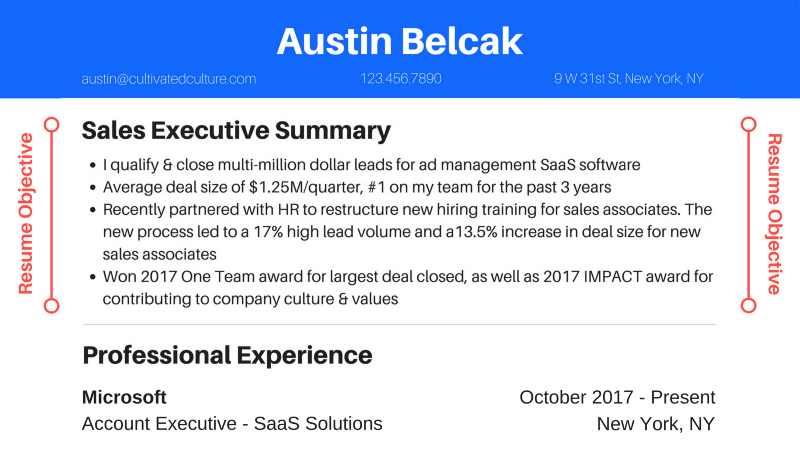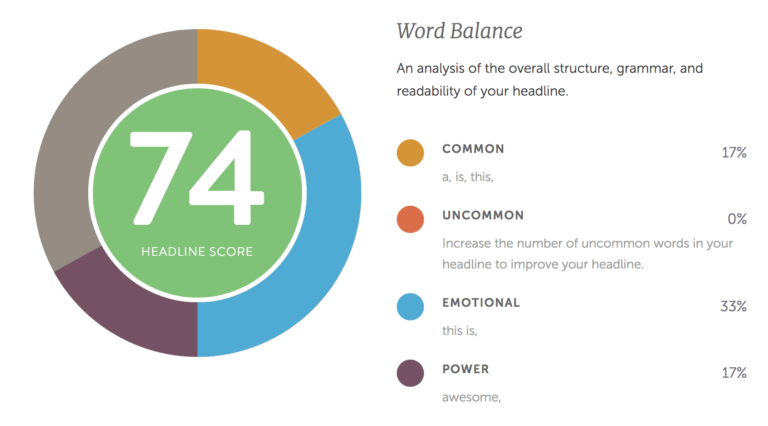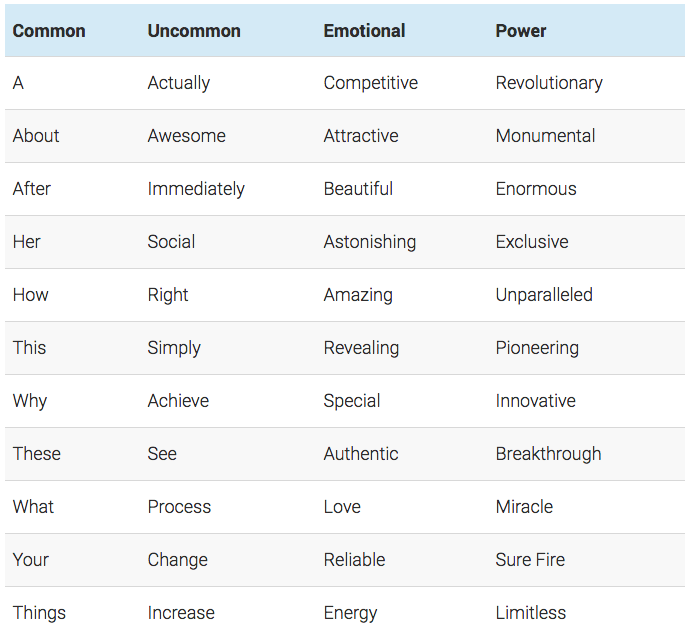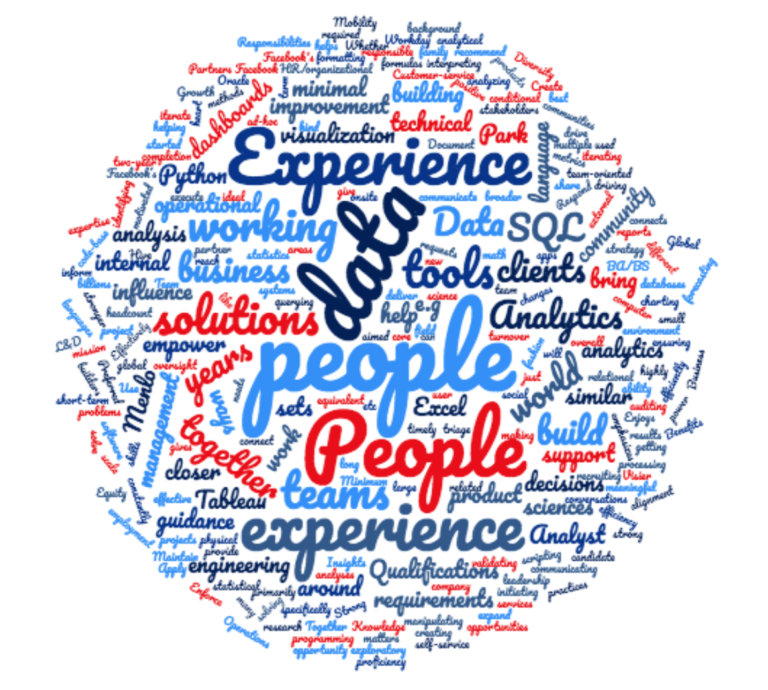by Austin Belcak
This is the only résumé objective advice you need to get hired
A few tweaks to this section of your résumé can triple your interview rate — and this is how to make it happen.

A good résumé objective is the difference between landing the interview and having your application tossed in the trash.
Here’s why:
You’ve probably heard that employers spend an average of six seconds scanning your résumé. But do you know where they spend the majority of that time?
Scanning the résumé objective.
It’s the easiest way for them to qualify (or disqualify) candidates, which is why it’s critical that you structure your objective in a way that’s easy to digest and hooks your potential employer from the first bullet.
This, my friend, is easier said than done. If you did a Google search for “résumé objective” you probably came across a bunch of conflicting advice that left you wondering:
- Should you use a résumé objective, summary, or profile?
- Should this section be a written paragraph or short bullets?
- What information should you include (and what should you leave out)?
- How do you take that generic template and apply it to your specific situation and industry?
At least that’s how I felt when I was looking for help during my job search. This article aims to change that. It’s going to be your one stop shop for crafting a résumé objective that achieves a single goal: getting you the interview and the job offer.
Here’s what we’re going to cover:
- Why the résumé objective is absolutely critical for beating the competition and landing the interview
- Three simple steps to crafting a résumé objective that gets you hired the first time
- Four incredibly common mistakes people make in the objective that costs them the interview
- Three sample résumé objectives for different industries and scenarios
Once you’re done with this article, go ahead and check out this guide on writing résumés that will actually get you hired (the first time).
What is a résumé objective (& why should you care)?
Your résumé objective is the first section that appears below your name and contact information on your résumé:

A highly effective objective includes 3–5 bullets of the most relevant experience and compelling results when compared to the job description.
Other career websites and “gurus” may advocate for different formats. Since founding Cultivated Culture, I’ve had thousands of résumés come across my desk which has given me the opportunity to test each style, collect data, and monitor success. The bullet-style that I’ll be walking you through in this article outperformed every other format.
It’s specifically designed to hook the reader, highlight the information they are using to qualify candidates, and deliver it in a format that is easy to digest. Here’s a quick comparison of the bullet-style vs. a paragraph style résumé objective (in the context of an outbound sales role):
Example of Bullet Style
- Manage an outbound sales team of six that achieves an average attainment of 123% to quota and was responsible for 40% of net new sales last year
- Restructured pitch process to incorporate “Challenger Sale” methodology, resulting in a 15% increase in sales and a 29% increase in average deal size
- Creator of embRACE, an internal group focused on building diversity and inclusion into the core of our company culture
Example of Paragraph Style
At [Company], I am responsible for managing a team of six sales people that have a track record of consistently over-attaining against quota and drove ~40% of net new sales last year for the company.
Most recently, I restructured our sales pitch process to incorporate a “Challenger Sale” mindset from the initial point of contact through to the close. It helped us increase our sell through rate by 15%, and increased our average deal size by 29% versus the previous process.
Finally, diversity and inclusion is a huge passion of mine. I created a group called embRACE which aims to help make diversity and inclusions a core pillar of our company’s culture.
See how the bullet style hooks you in from the first bullet and is much easier to digest? That’s what we’re going for. In a world where the average open role gets 300+ applications, grabbing attention early and making the information dead easy to comprehend is what will set you apart from the competition.
That said, not all bullet-style objectives are created equal. If your bullets aren’t catchy and they don’t deliver the information your reader was looking for, your résumé is going to get tossed. Here’s an example of good and bad bullet style résumé objectives:
“Bad” Example
- Responsible for managing a team of six outbound sales associates
- Restructured our pitch process to increase sales and drive more revenue
- Helped start an internal group focused on raising awareness about diversity and inclusion
Those bullets are extremely vague and don’t offer any tangible value. Those bullets could apply to any sales manager at a progressive company in 2018 — this person has no hope of standing out in a sea of applicants. Let’s see how these can be re-phrased to make this person’s résumé objective pop:
“Good” Example
- Manage an outbound sales team of six that achieves an average attainment of 123% to quota and was responsible for 40% of net new sales last year
- Restructured pitch process to incorporate “Challenger Sale” methodology, resulting in a 15% increase in sales and a 29% increase in average deal size
- Creator of “embRACE,” an internal group focused on building diversity and inclusion into the core of our company culture
If you were a hiring manager thumbing through your fifth stack of résumés, which one of these would catch your eye?
3 steps to crafting a résumé objective that gets results
Now I’ll show you a simple 3-step formula you can use to make sure you’re writing an objective that cuts through the BS and simply gets results:
1. Read the job description for the role you’re looking for
In order to ensure that the information in our objective is relevant and compelling, we need to understand what the company is truly looking for.
There’s a specific reason that this role is open. At a high level, the company is looking for someone to come in and excel at specific actions and activities. Digging deeper, we might find that the company needs this person to help them solve a problem, overcome an obstacle, or simply perform activities to help drive revenue.
To answer the high level question, the best place to start is the job description (JD). The JD will give us a sense of “hard” qualifications like:
- Years of experience
- Proficiency with certain tools, platforms, or programming languages
- Track record of success against key performance indicators
And so on.
When reading the JD, put yourself in the shoes of the hiring manager. What information would you immediately look for to determine if the person was qualified? In what order?
Let’s take a look at this Data Analyst role at Facebook. Here are a few bullets highlighting “hard” skills needed for the role:
- Responsible for ensuring the efficiency of Facebook’s People Data Team, identifying areas for improvement, and building both long term and ad-hoc solutions. The ideal candidate will have a strong technical, analytical, and operational background. SQL and Tableau proficiency is required.
- Use tools and programming languages like Tableau, Hive, Oracle, R, Python, Excel, Workday, Visier and many other internal tools to work efficiently at scale
- Maintain code-base (SQL) used to drive self-service tools, and recommend opportunities for improvement
- 3+ years experience with SQL (or similar language aimed at querying relational databases)
- 3+ years of experience working with data visualization tools
- 2+ years of experience with R, Python, or a similar scripting language
Based on that, we know our bullets should mention having 3+ years of experience with SQL, Tableau, and Python as well as tangible results that were driven by our analysis using those tools.
This strategy will give you a starting point to determine exactly what you need to include in order to pass the “eye” test for qualification. However, that’s just the beginning. The JD can only tell us so much about the role, and everyone else out there has access to it.
If you really want to stand a head and shoulders above the competition, we have to go a bit deeper. The best way to truly understand why the company is hiring for this role is to speak with people on the actual team — the person who might manage you, or a potential peer who would sit across from you if you got hired.
These people will be able to to give you inside information like:
“The title says “Account Executive” but this role is going to have a different focus than the other AEs. We identified a huge revenue opportunity within our mid-tier clients, but all of our current AEs are completely maxed out servicing our top clients. This role is going to solely focus on taking mid-tier accounts and growing them 3–5x.”
Or
“Our Project Management team is struggling to bridge the gap between sales and engineering. Sales is out there selling stuff that doesn’t exist, and engineering wants to focus their resources on features that clients aren’t necessarily asking for. The boss hopes that this new hire will have some experience liaising between sales/engineering to help us re-prioritize and get everyone on the same page so we stop leaking productivity and revenue.”
Those paragraphs contain some insanely valuable information for you as a job seeker. Stuff that you would never infer from an online job description. But it comes with a catch…
In order to get that information, you need to learn how to get in touch and build relationships with virtual strangers. I won’t dive into the details in this post, but here is a massive guide on building connections complete with all the strategies, tools, and templates you need turn strangers into loyal advocates.
Getting in touch with highly influential contacts at the company hiring for the role you want will help you further refine your bullets so that they speak directly to the exact void the company is looking to fill.
2. Compare the job description with your background
After scanning the job description and working through a few informational interviews, you want to think about which pieces of experience match with what the company is looking for.
Choosing The Right Experience
Remember, our goals with the résumé objective are to hook the reader and pre-qualify ourselves. That means we’re going to be structuring the bullets in this section a bit differently than we would in the experience section. Ideally, you want experience that fits this format:
Bullet 1: Summary of our background including language from the JD, tools/hard skills, and years of experience
Bullet 2: Highlight a specific project that showcases the use of hard/soft skills in the JD
Bullet 3: Highlight another project that showcases use of skills in the JD
Bullet 4: Highlight cultural fit and soft skills
This format immediately qualifies you in the first bullet, uses the next two to showcase specific case studies (proving your value), and wraps up with validation about your ability to fit in and collaborate. Our next step is to write these in a compelling fashion.
How To Write Highly Compelling Bullets
Now I need you to channel your inner marketer. Copywriting is an incredibly deep topic, so instead of diving in completely, I’m going to give you two quick formulas you can use to write highly effective bullets every time.
1) Problem, Action, Results
The best resume bullets follow a simple, three part structure:
- Problem
- Action
- Results (Quantitative/Measurable)
The first part of your bullet highlights the problem, the middle speaks to the action you took, and the end includes the measurable/quantitative results you achieved. It’s important to note that, in some cases, there isn’t a problem to highlight, in which case you’ll just speak to the actions taken and the results produced.
Here are some examples of bullets leveraging the PAR technique:
General Resume Objective Example
- Saved $100k/month account via funnel audit which allowed us to identify and fix two key issues. This resulted in a 17% increase in total sales for a 10% lower cost-per-sale. The client re-signed with us for 20% more two months later.
- Identified gaps in patient discharge process that inflated readmission rates. Led a team-wide training to illustrate the issue and detail the new process I created. Readmission rates dropped 7% the following month (saving an avg. of $1,257 per patient).
- Exceeded annual growth quota by 135% (#1 on my team), responsible for 80% of team-wide upselling in Q3 & Q4
2) Using The Right Language
Coschedule has taken copywriting and turned it into an absolute science. This post on word balance and choice is incredibly relevant to writing effective résumé bullets, and their headline analyzer tool is great for checking your word balance:

Here is what they recommend:
- Common words should make up 20–30% of your bullet
- Uncommon words should make up 10–20%
- Emotional words should come in at 10–15%
- You should include at least one power word in your bullet
Here are some examples for each word type:

If you combine the Problem, Action, Results formula with Coschedule’s recommended word balance, chances are pretty high that you have an awesome bullet for your résumé objective.
3) “Hacking” the online application algorithm
In addition to convincing a hiring manager, the words you choose for your résumé objective are also critical to helping you beat the applicant tracking software used by most companies.
When you hit “Submit” on that online application, it usually doesn’t end up in the hands of a human. Instead, it’s scanned by a piece of software called an Applicant Tracking System that chooses qualified candidates based on specific key words, phrases, and experience. Here’s a great video that walks through the ATS and how it affects your application:
He’s not joking when he says that only a handful of résumés actually make it into the hands of a real human. A Workopolis survey showed that Applicant Tracking Systems delete 98% of résumés programmatically.
If you want to make it into that 2%, you need to carefully choose the words and phrases you include in your résumé objective. Here’s a quick hack you can use to increase your chances of beating the system:
1. Go to the online job description for the role that you want.
2. Highlight all of the text pertaining to the role and copy it
3. Go to WordClouds, paste the job description into the tool, and create a word cloud
The cloud will give you a visual representation of which words appear most frequently (and are more likely to be taken into account by the applicant tracking software) in the job description. Here is a word cloud for the Data Analyst role from Facebook that I mentioned earlier:

The larger the word appears in the cloud, the more frequently it appears in the job description. If you’re more comfortable with an exact breakdown of the word count, you can click “Word List” in the tool, and Word Clouds will tell you exactly how many times each word appeared. For the cloud above, we have:
9 people
8 data
7 People
6 Experience
6 experience
4 solutions
4 working
4 teams
4 tools
3 Analytics
3 together
3 business
3 clients
3 world
3 years
3 build
3 Data
3 SQL
We want to incorporate as many of these words into our résumé objective bullets as we possibly can, because these are exactly what the Applicant Tracking Software is looking for.
Common Resume Objective Mistakes That Cost People The Interview
Despite following the advice above, I still see people making mistakes in their résumé objective that hurts their chances of edging out the competition and landing the interview. Here are the most common mistakes along with how you can avoid them:

Mistake #1: Writing a wall of text
According to the data I’ve collected, paragraph-style résumé objectives simply don’t perform very well. Hiring managers are sorting through hundreds of resumes, the last thing they want to do is read a 500 word essay on your life story.
What To Do Instead: The perfect length for your resume objective is 3–5 bullets that are no more than 50 words each. The easiest way to achieve this is by doing a brain dump (just write — don’t worry about length, word choice, etc.) to get your thoughts on paper. Then go back and rework each to achieve optimal length, word balance, and messaging.
Mistake #2: starting bullets with “Responsible For” writing in first person
Avoid starting each bullet with “Responsible for…” and don’t use the first person — “I did,” “I managed,” “I partnered,” etc. It may seem ticky tacky, but both of these come across as unprofessional and take away from the clarity of the value you bring to the table.
What To Do Instead: Always start your bullets with a verb and replace any “I [blank]” with the verb itself. For example:
- Instead of “Responsible for managing a team of 6 employees to grow existing business,” you should write, “Managed a team of 6 employees who exceeded annual quota by 27% (#2 in the company).”
- Instead of “I created a new process that helped increase onboarding efficiency,” you should write, “Created a new onboarding process that decreased the time from handshake to payment by 47% (7 days).”
Mistake #3: Focusing on yourself and your goals instead of the company.
I hate to break it to you, but employers don’t really care about what you want. They care about themselves and what they need to solve problems and drive revenue. If your résumé objective is centered on you and what you want, it’s probably going to get tossed.
What To Do Instead: Leverage the information from the job description and the informational interviews you conducted to understand exactly why the company is hiring for this role. Then position your bullets to align directly with that need.
Mistake #4: Not using a résumé objective on your resume.
What To Do Instead: It sounds obvious, but you’d be surprised by how many people’s résumés go straight from contact info to professional experience.
Regardless of the résumé format you’re using, the professional experience section tends to contain a lot of info. You don’t want the reader to have to search for the info they are looking for, you want to put it right under their nose.
The résumé objective is a huge opportunity to pre-qualify yourself and stand out from the competition. Don’t take it for granted.
General résumé objective examples (for 3 different industries & job titles)
Now that you know how to craft a highly effective résumé objective from scratch, let’s take a look at a few examples of fantastic objectives from different industries and roles:

Example #1 — Front End Web Developer
Dashlane, a password management and digital wallet startup, is looking to hire a Front End Developer. Here is their description:
You have a passion for implementing high-quality, data-driven UI/UX experiences on the web. You have a strong passion for client-side as well as server-side Javascript. You will be focused on creating beautiful user experiences for our payment checkout, lead generation forms, paid landing page campaigns, and much more while at the same time pro-actively extending and optimizing our proprietary website and email back-end technology, and our many continuous integration and deployment tools. Qualified candidates will:
- Take ownership of not only the features you develop, but all aspects of the Dashlane website and other projects owned by the FED team (ie. Emails project, help center, blog, 3rd-party integrated tools)
- Collaborate with Marketing, Design, QA, and other developers to ensure beautifully crafted UX/UI experiences and effective implementations that get results and are delivered quickly
- 3 years or more of professional Front End Web Development experience
- Advanced skills in HTML5 and CSS3 (ie. Flexbox, Templating engines, CSS preprocessing)
- Advanced skills in Javascript (not jQuery, we write vanilla ES6)
- Strong command of server-side programming and principles using Node.js or similar
- Working knowledge of version control (ie. Git, Mercurial, etc)
- Prior startup experience preferred
Here’s what a strong résumé objective might look like for this role:
Front End Development Summary
- Front end developer with 4 years experience (at two startups) designing, building, and implementing web applications in HTML5, CSS3, Javascript ES6, and Node.js
- Completely audited and overhauled sales funnel UX for [Current Company]. Redesigning email captures, thank you pages, and checkout flow led to 49% increase in subscribers and 34% increase in sales conversion rate (vs. previous design)
- Partnered with sales, marketing, and QA to rebuild email back end and integrate with CRM at [Previous Company]. Three major phases were all completed at least 2 weeks ahead of schedule.
- Studying self-curated curriculum on the psychology of design with courses from MIT, Stanford, and Princeton
While “success” for software/web development is fairly objective, having proven results from other teams helps strengthen the case:
- The first bullet hits the experience quota, the preference for experience at startups, and the “hard skills” of specific programming languages
- The second bullet speaks to an experience that directly aligns to what Dashlane is looking for. They want someone to help improve their lead capture and checkout flow, this person cites an experience doing exactly that with outstanding results (that they got from marketing or sales)
- The third bullet shows that this person isn’t shy about being a team player and has experience understanding needs, managing expectations, and delivering ahead of schedule (a rare thing)
- Finally, this person illustrates that they are hungry to learn and hone their skill set by taking relevant courses in their personal time
Now let’s take a look at another sample résumé objective for a very different type of role:
Example #2 — Marketing Director
Monaeo, a location intelligence startup, is looking to hire a Director of Growth Marketing. Here is their description:
As the Director of Lead Generation, you will define strategy and execute integrated lead generation programs. You will report to the founder and work closely with cross-functional teams across Sales, Marketing, Design and Engineering to grow our customers globally.
This would be an opportunity for you to have significant independence, work on challenging problems, define the design process, and have immediate & tangible impact. Qualified candidates will:
- Drive all Lead Generation efforts, including setting strategy, developing forecasts, executing, and measuring results
- Create, manage and monitor performance for all Lead Generation initiatives including email campaigns, content marketing, nurture programs, webinars, events, partner channels, SEO, SEM/paid channels, and other opportunities to drive revenue
- Model and forecast results; conduct A/B tests and use a data-driven approach to refine and enhance outcomes in order to hit KPI targets like inquiries, MQL, and sales active pipeline
- Have 5+ years of experience in B2B and B2B2C SaaS marketing with a proven track record of driving growth in a lead generation role
- Knowledge of B2B marketing methods (specifically lead generation), Martech tools (such as Hubspot, Marketo, Intercom, Yesware etc.) and strategies
Here’s what a good résumé objective might look like for this role:
Growth Marketing Summary
- Growth marketer with 6+ years of experience designing innovative lead generation campaigns resulting in an average of 587% increase in monthly leads for previous three companies
- At [Current Company], structured A/B lead form test in Hubspot led to 17% lift in daily subscribers, ConvertKit evergreen campaign warmed up leads over 14 day period and increased sell-through-rate by 23% (~156 additional sales per month).
- At [Previous Company], systematic partner webinar outreach within shoulder industries increased daily qualified leads by 37% (345 incremental leads) and dropped overall cost-per-sale by 13%
- Adept at creating effective email campaigns, partner webinars, and search engine marketing/PPC to drive results. Highly proficient with martech tools like ConvertKit, Intercom, Hubspot, Yesware, Hootsuite, Google Analytics, & more
Marketing roles are prime candidates for this style of résumé objective, because their metrics for success are easily measured. This objective is great because:
- The first bullet qualifies the experience criteria and immediately proves out a track record of value
- Bullets two and three breakdown these results in more detail and showcase that this person isn’t a one trick pony. They are leveraging multiple channels and platforms to find creative ways to drive real results
- The final bullet is a keyword play that pre-qualifies this person on all of the platforms and channels the company had asked for in their job description
Finally, we’ll take a look at a role that doesn’t rely on concrete, objective criteria for success:
Example #3 — Graphic Designer
FreshDirect, a New York based grocery deliver service, is looking to hire a graphic designer. Here’s their job description:
You will contribute to the creative team’s production of strategic and innovative design to support consumer selling and engagement for internal clients and partners, including consumer marketing, merchandising, and the website and human resources teams. Candidates should be ready to roll up their sleeves and get involved in everything we do, from digital and print marketing material, to banner ads and website assets, with a particular focus on e-mail, website, and content marketing efforts in service of customer engagement, conversion and retention. Qualified candidates will:
- Under the direction of a Senior Designer, conceive and design e-mail, print, other digital and mobile material, including banner ads, social media graphics, photo retouching and cropping, landing pages, as necessary to meet client needs
- Scout and share design and digital marketing innovations from others in the industry and around the web
- 4–6 years in digital and/or print design, art or related field. Experience in the direct marketing field a strong plus
- In-depth knowledge and experience with the Adobe Creative Suite, including Photoshop, Illustrator and InDesign
A great résumé objective might look like this:
Graphic Design Summary
- Designer with 6+ years of “conversion-focused” graphic design proven to increase engagement, conversion rates, and retention for multiple startups
- Pitched “Find Your Place” campaign for apartment rental company — design led to 46% boost in sign ups, 57,000 shares on social media, and earned media placements in Business Insider, Forbes, etc.
- Passionate about studying and testing conversion-focused design, specifically leveraging Reddit to experiment with new styles and track virality/exposure of different concepts
Some roles, like graphic design, are less focused on quantitative metrics. That said, you still need a way to prove out your value. This objective is effective because:
- The first bullet meets the experience qualification but also introduces this concept of “conversion focused” design, which the company alluded to when they said “in service of customer engagement, conversion and retention.”
- The second bullet proves out value. Just because graphic designers don’t have a quota doesn’t mean they can’t measure the impact of their work. All it takes is walking over the sales or marketing and getting a debrief from them after the campaign. It’s also easy to track things like social shares and mentions on BuzzSumo.
- The final bullet shows that this person is invested in their craft outside of the office, and they view graphic design as a science. They’re staying up to date with new trends in design and actually testing them in the real world to see what gets results. Talk about a go getter!
Putting it all together
Whew! That was a LOT of info — hopefully it lived up to the hype of being a one stop shop for your résumé objective. I wanted to make sure I covered every detail so you can start taking action that actually gets results.
The objective is just one piece of your résumé, though. There is a lot more that goes into crafting a résumé that consistently edges out the competition. When you’re ready, I recommend checking out my guide on writing résumés that actually get you hired.